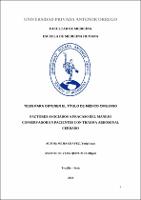Factores asociados a fracaso del manejo conservador en pacientes con trauma abdominal cerrado

Ver/
Descargar
(application/pdf: 406.6Kb)
(application/pdf: 406.6Kb)
Fecha
2018Autor(es)
Mejia Chavez, Yosip Isaac
Metadatos
Mostrar el registro completo del ítemResumen
Objetivo: El objetivo de este estudio fue investigar mediante un análisis bivariado,
multivariado los factores asociados al fracaso de manejo conservador de pacientes
con trauma abdominal cerrado, además de construir un modelo de predicción.
Material y métodos: Estudio de retrospectivo, observacional, seccional,
transversal en 142 pacientes con diagnóstico de trauma abdominal cerrado quienes
se dividieron en 2 grupos: con fracaso al tratamiento no quirúrgico y con éxito a
este tratamiento. Se calcularon el test de chi cuadrado y se aplicó el análisis
multivariado.
Resultados: Las características clínicas relacionadas con el fracaso en el
tratamiento conservador en el análisis bivariado fueron el tener una mayor edad
(años)(p = 0.001), el tener menor nivel de hematocrito y de pH (p = 0.001
respectivamente)y el tener valores más elevados de glucemia y de creatinina (p =
0.001 respectivamente) y presencia de acidosis (OR: 10,73; IC 95% [4,28-26,89];
p = 0,001) y necesidad de transfusiones (OR: 7,07; IC 95% [2,94-16,98]; p = 0,001).
La lesión del bazo se asoció con la necesidad del tratamiento no quirúrgico en
pacientes con trauma abdominal cerrado, pero quienes lo presentan tienen más
riesgo de fracaso. En el análisis multivariado la presencia de acidosis y la necesidad
de transfusión sanguínea fueron factores asociado al fracaso del tratamiento no
quirúrgico en pacientes con trauma abdominal cerrado, sin embargo con respecto a
la edad al tener un coeficiente beta negativo (-0.05), y un OR (0.95), se interpreta
que por cada año que disminuya el riesgo baja en 5%.
Conclusiones: La acidosis y la necesidad de transfusión sanguínea fueron factores
asociados al fracaso del manejo conservador en pacientes con trauma abdominal
cerrado. Objective: The objective of this study was to investigate, through a bivariate,
multivariate analysis, the factors associated with the failure of the management of
the patient with closed abdominal trauma, in addition to constructing a prediction
model.
Material and methods: Retrospective, observational, sectional, cross-sectional
study in 142 patients with a diagnosis of closed abdominal trauma who were divided
into 2 groups: with failure to non-surgical treatment and with success to this
treatment. The chi square test was calculated and the multivariate analysis was
applied.
Results: The clinical characteristics related to the failure in the conservative
treatment in the bivariate analysis were having a higher age (years) (p = 0.001),
having a lower hematocrit level and ph. (p = 0.001, respectively) and having more
high blood glucose and creatinine levels (p = 0.001 respectively) and the presence
of acidosis (OR: 10.73, 95% CI [4.28-26.89]; p = 0.001) and need for transfusions
(OR: 7.07 95% CI [2.94-16.98], p = 0.001). Spleen injury was associated with the
need for non-surgical treatment in patients with closed abdominal trauma, but those
who present it have a higher risk of failure. In the multivariate analysis, the presence
of acidosis and the need for blood transfusion were the factors associated with the
failure of non-surgical treatment in patients with closed abdominal trauma, however
with respect to age, having a negative beta coefficient (-0.05), and an O (0.95), it is
interpreted that for each year that the risk decreases, it decreases by 5%.
Palabras clave
Colecciones
- Medicina Humana [2969]

